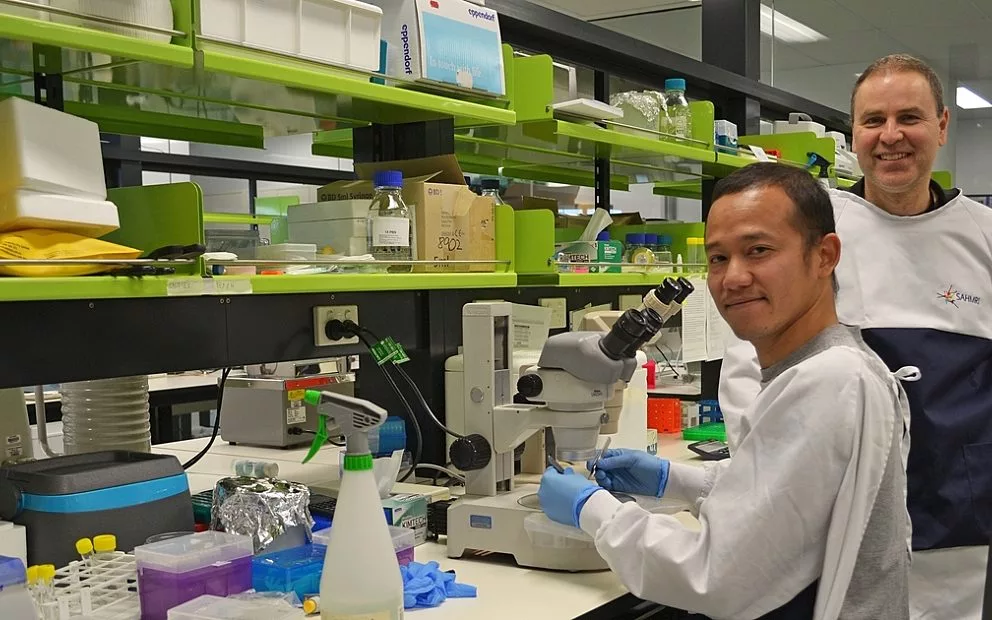IN the emotional world of cancers there are the Big Five cancers that get loads of attention, funding and research — and then there are the ‘forgotten cancers.’
Breast, bowel, prostate, melanoma and lung cancer account for 60 per cent of cancer diagnoses.
They touch thousands of people. In turn, they get funding and publicity, such as October being designated Breast Cancer Awareness Month.
They have political clout and even play out on gender lines, such as appeals for funding and support for breast cancer and prostate cancer research.
Big Five aside, there are more than 200 other cancers which also affect thousands of families each year. No-one really wants to talk about bum cancer.
The Cancer Council is now seeking people with these lesser known cancers for one of the largest studies of its type.
The Forgotten Cancers Project aims to recruit 15,000 people — an ambitious target as there are fewer people diagnosed with or who survive these cancers, which means there are fewer eligible participants.
The research project is being run by Cancer Council Victoria and is now seeking South Australians to take part.
It comes as the Cancer Council forecasts the number of cancer patients is expected to increase by up to 30 per cent over the next 10 years due to an ageing population and the fact that cancer occurs more commonly in older people.
As more Australians live to a ripe old age, it is estimated one in every two Australian men and one in every three Australian women will be diagnosed with cancer by the age of 85.
These will include rare cancers.
The huge number of ‘forgotten cancers’ means the research initially will focus on 15 diseases, based on their poor survival rates and a limited understanding of their causes.
The target cancers are: non-Hodgkin lymphoma, leukaemia, multiple myeloma, kidney, bladder, stomach, brain, liver, oesophagus, pancreas, uterus, thyroid, gallbladder, small intestine and bone cancer.
Researchers want adults who have been diagnosed with one of the cancers, and also a family member who is not affected by the same cancer.
The project will look at lifestyle factors, family history of cancer, medical history and occupational history. Participants will also be asked to provide DNA from a saliva sample to identify genetic variants associated with an increased risk of the targeted cancers.
Mawson Lakes midwife Vaaldir Thrupp (Vaaldir Thrupp) is one of the first to take part.
Mrs Thrupp, 65, was diagnosed with the incurable blood cancer Non Hodgkin Lymphoma on Christmas Eve, 1997, after finding a lump in her armpit.
“My doctor said there was good news and bad news,” she recalls. “The good news was I would not need chemotherapy, the bad news was they can’t cure it.”
Mrs Thrupp has defied the odds in the years since, enjoying life with husband Peter, her three children and three grandchildren.
Treatment including radiotherapy has kept the cancer at bay and not markedly affected her lifestyle.
Mrs Thrupp noted the major cancers such as breast cancer get lots of attention but many other cancers are little known by the public.
“When a rock star gets one it might hit the headlines, but really you only hear about a handful normally,” she said.
“This project hopefully will lead into some new understanding of the lesser known cancers.”
The Forgotten Cancers Project comes as the South Australian Health and Medical Research Institute (SAHMRI) steps up its investigations into cancer.
SAHMRI’s Cancer Theme is backed by Council Council SA’s Beat Cancer Project — a $10 million investment, equally matched by SA Health, which is now funding more than 70 research projects including into some of the lesser known cancers with the hope a breakthrough in any one cancer may be useful in treating others.
The Cancer Theme has recruited Professors Deborah White and Timothy Hughes from SA Pathology who have brought their research groups to SAHMRI.
The White/Hughes group are world leaders in the biology and treatment of chronic myeloid leukaemia.
The research groups of Professors Andrew Zannettino and Stan Gronthos will also move to SAHMRI, bringing expertise in mesenchymal stem cell and myeloma biology.
In addition, the prostate cancer research team of Associate Professor Lisa Butler is in the process of moving to the SAHMRI Cancer Theme. Plans are also underway to relocate the South Australian tumour bank to SAHMRI, which will grow to enable optimal banking of tumour samples Australia wide.
The Cancer Theme is also establishing solid tumour “nodes” at the Flinders Centre for Innovation in Cancer and the Basil Hetzel Institute.
The Beat Cancer Project has the simple aim of a future without cancer.
That includes the forgotten cancers such as brain cancer.
Eminent neurosurgeon Charlie Teo has set up the Cure For Life Foundation for research into brain cancer.
In a recent interview with the Sunday Mail he stressed one big problem with drumming up support for brain cancer is that all victims die.
So they don’t have champion survivors to push their cause.
“It’s the number one cancer killer of children — it kills more children than leukaemia, it’s the number one cancer killer of woman aged under 39, killing more women under 39 than breast cancer,” Dr Teo said. “Yet it doesn’t have the same profile as those diseases.
“One reason is we don’t have too many ambassadors because they all die. You have Olivia Newton-John being a great voice for breast cancer and Delta Goodrem for non-Hodgkin’s lymphoma, but we have had no-one survive. Stan Zemanek was a journalist in Sydney, Andrew Olle was a journalist with the ABC, Chris O’Brien was a high profile celebrity doctor — every one of them died with three years of diagnosis.
“No-one survives. It is the deadliest cancer known to mankind.”
Dr Teo has a simple request to the Federal Government.
“Please fund brain cancer in proportion to its impact on society,” he said. “It has the most impact, but is least-funded. Breast cancer research gets many millions a year, brain cancer gets $100,000. Look what funding has done for breast cancer — it has given them treatment options, it is a great thing all that money has been put into breast cancer and leukaemia.
“Thirty years ago leukaemia had a 90 per cent mortality rate, now through funding and research leukaemia has a 90 per cent cure rate.
“That’s what we want with brain cancer.”
PLUCKY ERIN’S FIGHTING SPIRIT LIVES ON
ALDINGA Beach teenager Erin Griffin planned to be in Washington this week speaking at the CureFest conference about funding for childhood cancer.
Her mother, Amanda, and brother Declan went in her place. Erin, 14, shrugged off her limited life expectancy outlook to live about three years longer than expected but her incurable brain cancer finally caught her earlier this month.
Erin Griffin has been raising childhood cancer awareness.
The teen with piercing blue eyes and Scottish-heritage determination packed loads into every day, initially keeping her diagnosis secret so friends would not treat her differently, then mounting a campaign for awareness of brain cancer and childhood cancers.
The new Adelaide footbridge is lit in gold this month as a subtle reminder of people dealing with cancer, courtesy of Premier Jay Weathrill.
Prior to leaving for Washington, Ms Griffin told the Sunday Mail Erin was devastated she was too sick to go, having spoken previously at the event.
“Wish you were here in person, but I know you are here within our hearts,” Ms Griffin wrote on Erin’s Facebook page this week.
Mrs Griffin and Declan spoke at CureFest then joined a candlight vigil outside the White House to lobby for research funds.
Erin had began a petition to the Senate to make childhood cancer research a priority. It now has more than 7000 signatures.
She wrote: “My name is Erin Griffin, I am 13 years old and I have brain cancer ... All childhood cancers need a cure and it isn’t fair that children are dying because there’s no treatments for them.
“Children have their whole lives ahead of them. Kids are our future, but lots of kids with cancer don’t get a chance to grow up because there is not enough awareness and not enough funding or treatments. There are children dying every day from cancer. This is not right and this needs to change. There needs to be more awareness and I’m going to help make this happen.”
Speaking from Washington, Erin’s brother Declan said brain cancer is the biggest killer of children by diseases.
“I am here on my sister’s behalf to raise awareness of childhood cancers,” he said.


